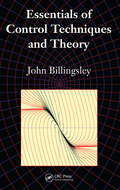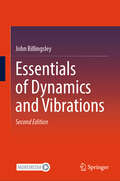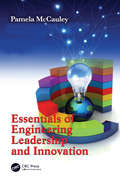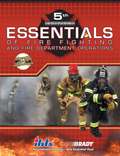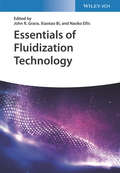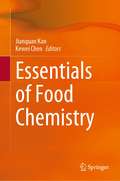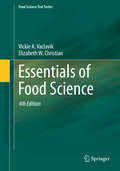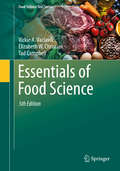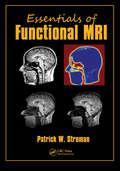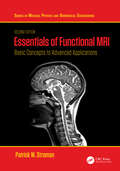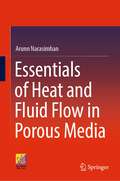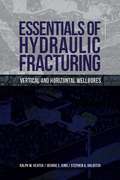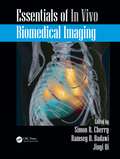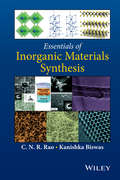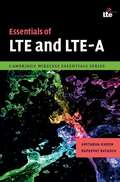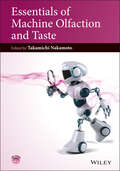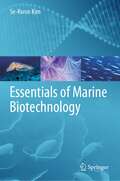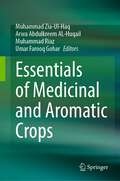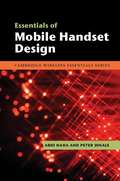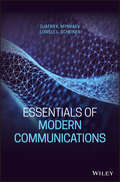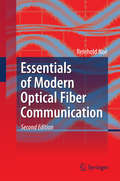- Table View
- List View
Essentials of Control Techniques and Theory
by John BillingsleyCarefully separating the essential from the ornamental, Essentials of Control Techniques and Theory presents the nuts and bolts for designing a successful controller. It discusses the theory required to support the art of designing a working controller as well as the various aspects to convince a client, employer, or examiner of your expertise.A Compelling Account of the Basics of Control TheoryControl solutions for practicing engineersUsing the author’s own Javascript On-Line Learning Interactive Environment for Simulation (Jollies), the text relies on computer-based graphical analysis methods, such as Nyquist, Nichols, root locus, and phase-plane, to illustrate how useful computer simulation can be for analyzing both linear and nonlinear systems. It explains step-by-step the design and modeling of various control systems, including discrete time systems and an inverted pendulum. Along with offering many web-based simulations, the book shows how mathematics, such as vectors, matrices, and the differential equations that govern state variables, can help us understand the concepts that underpin the controller’s effects. From frequency domain analysis to time-domain state-space representation, this book covers many aspects of classical and modern control theory. It presents important methods for designing and analyzing linear systems and controllers.
Essentials of Digital Signal Processing
by B. P. Lathi Roger A. GreenThis textbook offers a fresh approach to digital signal processing (DSP) that combines heuristic reasoning and physical appreciation with sound mathematical methods to illuminate DSP concepts and practices. It uses metaphors, analogies and creative explanations, along with examples and exercises to provide deep and intuitive insights into DSP concepts. Practical DSP requires hybrid systems including both discrete- and continuous-time components. This book follows a holistic approach and presents discrete-time processing as a seamless continuation of continuous-time signals and systems, beginning with a review of continuous-time signals and systems, frequency response, and filtering. The synergistic combination of continuous-time and discrete-time perspectives leads to a deeper appreciation and understanding of DSP concepts and practices. • For upper-level undergraduates • Illustrates concepts with 500 high-quality figures, more than 170 fully worked examples, and hundreds of end-of-chapter problems, more than 150 drill exercises, including complete and detailed solutions • Seamlessly integrates MATLAB throughout the text to enhance learning
Essentials of Dynamics and Vibrations
by John BillingsleyThis updated second edition brings the complex mathematics of three-dimensional dynamics to life with real-time simulations, making the equations easier to grasp. Covering core topics in mechanical engineering such as kinematics, dynamics, vibration analysis, gyroscopes, gears, and Euler’s equations, the book offers a clear and engaging approach for students, professionals, and enthusiasts alike. With a focus on practical applications, it explains everything from the laws of motion to motors and mechanisms, providing a comprehensive understanding of mechanical systems. New to this edition is a chapter on Power, Energy, and Perpetual Motion, which reveals intriguing comparisons, such as the energy needed to lift water versus the heat required to warm it. The final chapter, Rocket Science, has been expanded to debunk myths about black holes and gravity, humorously addressing science fiction misconceptions while proposing exciting space projects.
Essentials of Engineering Leadership and Innovation (Systems Innovation Book Series)
by Pamela McCauleyThis book is a must-have resource for those engineering professionals seeking out best practice in engineering leadership and innovation. It is underpinned by years of applied experience in engineering settings, and is designed to develop and prepare engineers as leaders to accept the technical and managerial challenges that they will face as professionals At a time when engineering and innovation in technology is of importance on so many fronts, this text encourages engineers and technical professionals to become effective, socially conscious leaders and innovators. The text and course material is designed to create an environment of interactive, high-engagement learning that will produce lifelong skills. Some of the many benefits of this book include: Accompanying notes, instructor’s manual, sample syllabi for qualifying textbook adoption; A complementary website with a wealth of ancillary resources; Case studies in STEM contexts; An international approach, underpinned by years of experience in US settings; Practical advice on how to distinguish yourself as an engineering leader; A solid grounding in ethics and professional responsibility. Drawing together best practice in engineering leadership education, and current research in the field, this book is an essential read for those wishing to develop expertise in engineering leadership. Current professionals in the field, educators as well as students of engineering wishing to excel, will all be particularly interested readers.
Essentials of Fire Fighting (5th edition)
by Carl Goodson Lynne MurnaneThe 5th edition of Essentials of Fire Fighting offers bold new learning packages for students. There are several new components, all designed to add to the success of the student. In addition, established components have been improved.
Essentials of Fire Fighting and Fire Department Operations
by IfstaContinuing the tradition of excellence in firefighter education, this new, expanded version contains the complete 20 basic chapters, as well as additional chapters including first aid and hazardous materials response to meet all of the requirements for Fire Fighter I and II levels of NFPA 1001® and NFPA 472® and OSHA 1910. 120. This overhauled new edition offers a complete support package and includes updated information on 192 skill sheets, knot and rope requirements, the use of essential job tasks related to the medical requirements in NFPA 1582®, and more! Begin laying the foundation for your firefighting career now with this expanded version. View a Sample Chapter:http://info. ifsta. org/essentials-6th
Essentials of Fire Fighting and Fire Department Operations (5th Edition)
by Carl Goodson Lynne MurnaneThe Essentials of Fire Fighting and Fire Department Operations manual is intended to provide the firefighter candidate with the information needed to meet the fire-related performance objectives in NFPA 1001, Standard for Fire Fighter Professional Qualifications. The methods shown throughout the manual have been validated by the International Fire Service Training Association (IFSTA) as accepted methods for accomplishing each task.
Essentials of Fluidization Technology
by John R. Grace Xiaotao Bi Naoko EllisA concise and clear introduction to the basics of fluidization, with a view to its applications in the process and energy industries.
Essentials of Food Chemistry
by Jianquan Kan Kewei ChenThis book presents fundamental and practical information on food chemistry. Using 2-D barcodes, it illustrates the specific reactions and potential transformation mechanisms of food constituents during various manufacturing and storage processes, and each chapter features teaching activities, such as questions and answers, and discussions. Further, it describes various local practices and improvements in Asia. Divided into 12 chapters covering individual nutrients and components, including water, proteins, carbohydrates, lipids, vitamins, minerals, enzymes, pigments, flavoring substances, additives, and harmful constituents, it addresses their food chemistry, as well as their transformations during manufacturing processes, and typical or advanced treatments to improve food quality and safety. This book helps college students to gain a basic understanding of nutrients and food components, to discover and implement the practical industrial guidelines, and also to learn the latest developments in food chemistry.
Essentials of Food Science
by Vickie A. Vaclavik Elizabeth W. ChristianThe fourth edition of this classic text continues to use a multidisciplinary approach to expose the non-major food science student to the physical and chemical composition of foods. Additionally, food preparation and processing, food safety, food chemistry, and food technology applications are discussed in this single source of information. The book begins with an Introduction to Food Components, Quality and Water. Next, it addresses Carbohydrates in Food, Starches, Pectins and Gums. Grains: Cereals, Flour, Rice and Pasta, and Vegetables and Fruits follow. Proteins in Food, Meat, Poultry, Fish, and Dry Beans; Eggs and Egg Products, Milk and Milk Products as well as Fats and Oil Products, Food Emulsions and Foams are covered. Next, Sugar, Sweeteners, and Confections and a chapter on Baked Products Batters and Dough is presented. A new section entitled Aspects of Food Processing covers information on Food Preservation, Food Additives, and Food Packaging. Food Safety and Government Regulation of the Food Supply and Labeling are also discussed in this text. As appropriate, each chapter discusses the nutritive value and safety issues of the highlighted commodity. The USDA My Plate is utilized throughout the chapters. A Conclusion, Glossary and further References as well as Bibliography are included in each chapter. Appendices at the end of the book include a variety of current topics such as Biotechnology, Functional Foods, Nutraceuticals, Phytochemicals, Medical Foods, USDA Choosemyplate. gov, Food Label Health Claims, Research Chefs Association certification, Human Nutrigenomics and New Product Development.
Essentials of Food Science (Food Science Text Series)
by Vickie A. Vaclavik Elizabeth W. Christian Tad CampbellThe fifth edition of the Essential of Food Science text continues its approach of presenting the essential information of food chemistry, food technology, and food preparations while providing a single source of information for the non-major food science student. This latest edition includes new discussions of food quality and new presentations of information around biotechnology and genetically modified foods. Also new in this edition is a discussion of the Food Safety Modernization Act (FSMA), a comparison chart for Halal and Kosher foods and introductions to newly popular products like pea starchand the various plant-based meat analogues that are now available commercially and for household use. Each chapter ends with a glossary of terms, references, and a bibliography. The popular “Culinary Alert!” features are scattered throughout the text and provide suggestions for the reader to easily apply the information in the text to his or her cooking application. Appendices at the end of the book include a variety of current topics such as Processed Foods, Biotechnology, Genetically Modified Foods, Functional Foods, Nutraceuticals, Phytochemicals, Medical Foods, and a Brief History of Foods Guides including USDA Choosemyplate.gov. V.A. Vaclavik, Ph.D., RD. has taught classes in nutrition, food science and management and culinary arts for over 25 years at the college level in Dallas, Texas. She is a graduate of Cornell University, human nutrition and food; Purdue University, restaurant, hotel, institution management; and Texas Woman’s University, institution management and food science. Elizabeth Christian, Ph.D. has been an adjunct faculty member at Texas Woman’s University for more than 25 years, teaching both face-to-face and online classes in the Nutrition and Food Science department. She obtained her B.S. and her PhD. In Food Science from Leeds University, England, and then worked as a research scientist at the Hannah Dairy Research Institute in Scotland for Five years before moving to the United States. Tad Campbell, MCN, RDN, LD is a clinical instructor at The University of Texas Southwestern Medical Center at Dallas, where he teaches Food Science and Technology as well as other nutrition courses in the Master of Clinical Nutrition – Coordinated Program. He holds a Bachelor of Business Administration degree from Baylor University as well as a Master of Clinical Nutrition from UT Southwestern where he studied Food Science under Dr. Vickie Vaclavik.
Essentials of Functional MRI (Series in Medical Physics and Biomedical Engineering)
by Patrick W. StromanDuring the last two decades, new developments in functional MRI (magnetic resonance imaging) have made it possible to detect changes in the brain over time, as opposed to the "snapshot" produced by conventional MRI. Essentials of Functional MRI breaks down the technical challenges for physicians, researchers, and technologists who use functional MR
Essentials of Functional MRI: Basic Concepts to Advanced Applications (Series in Medical Physics and Biomedical Engineering)
by Patrick W. StromanEssentials of Functional MRI is explained from the basic theory underlying magnetic resonance imaging. This includes how it can be used to detect dynamic variations in neural activity to become “functional” MRI, and how fMRI can be used for a variety of applications. The reader will gain an understanding of how fMRI is currently used, its limitations, and how it is still developing. This is achieved by explaining the core concepts and building on them to explain how fMRI data are acquired and what physiological information they provide. These ideas are the key to understanding how the data are analyzed to detect physiological changes that are related to neural activity. With an understanding of the basic underlying concepts, the way that fMRI is used, and its limitations, are much easier to understand. This 2nd edition includes explanations of new advances in MRI techniques and fMRI data analysis methods, and updated examples of applications of fMRI, including current or future clinical applications. This book is intended for students, researchers, and clinicians, who want to understand the theory and practice of fMRI in sufficient detail to use it for neuroscience research, clinical research, and for clinical practice.
Essentials of Heat and Fluid Flow in Porous Media
by Arunn NarasimhanThis textbook provides a general overview of porous media flow, and introduces various theoretical tools to characterize and predict the flow. It has been written for graduate and advanced graduate students in various engineering disciplines. It includes the topics such as fluid flow, conduction, convection, and radiation in porous media as well as porous medium aspects of biological systems. The concepts are supported by numerous solved examples to aid self-learning in students. The textbook also contains illustrated diagrams for better understanding of the concepts. This textbook will be useful for the core course of "Flow through Porous media" for graduate and advanced graduate students in various engineering disciplines. This textbook will also serve as a refresher course for researchers who are engaged in research related to porous media flow.
Essentials of Hydraulic Fracturing: Vertical and Horizontal Wellbores
by George King Ralph Veatch Stephen HolditchHydraulic fracturing was first developed in the United States during the 1940s and has since spread internationally. A proven technology that is reaching deeper and tighter formations, hydraulic fracturing now delivers hydrocarbons from fields previously considered economically unviable. Essentials of Hydraulic Fracturing focuses on consolidating the fundamental basics of fracturing technology with advances in extended horizontal wellbores and fracturing applications. It provides the essentials required to understand fracturing behavior and offers advice for applying that knowledge to fracturing treatment design and application. Essentials of Hydraulic Fracturing is a long-awaited text for petroleum engineering students, industry-wide hydraulic fracturing training courses or seminars, and practicing fracturing treatment engineers. Features include: Understanding of fracture propagation geometry and fracture conductivity and how it affects treatment results A focus on safety and environmental prudence Economic optimization of fracturing treatments Fracturing fluid system and propping agent performance Important considerations in designing the fracture treatment for both vertical and horizontal wellbores Algorithms and examples pertinent to treatment design and analysis Pre- and post-fracturing approaches and diagnostics for evaluating treatment performance Hydraulic fracturing model construction and applicability Comparative design examples Construction of spreadsheet calculations key to treatment designs
Essentials of In Vivo Biomedical Imaging
by Simon R. Cherry Ramsey D. Badawi Jinyi QiWhile there are many excellent texts focused on clinical medical imaging, there are few books that approach in vivo imaging technologies from the perspective of a scientist or physician-scientist using, or interested in using, these techniques in research. It is for these individuals that Essentials of In Vivo Biomedical Imaging is written.Featurin
Essentials of Inorganic Materials Synthesis
by C. N. Rao Kanishka BiswasThis compact handbook describes all the important methods of synthesis employed today for synthesizing inorganic materials. Some features: Focuses on modern inorganic materials with applications in nanotechnology, energy materials, and sustainability Synthesis is a crucial component of materials science and technology; this book provides a simple introduction as well as an updated description of methods Written in a very simple style, providing references to the literature to get details of the methods of preparation when required
Essentials of LTE and LTE-A
by Amitabha Ghosh Rapeepat RatasukThis practical, one-stop guide will quickly bring you up to speed on LTE and LTE-Advanced. With everything you need to know about the theory and technology behind the standards, this is a must-have for engineers and managers in the wireless industry. • First book of its kind describing technologies and system performance of LTE-A • Covers the evolution of digital wireless technology, basics of LTE and LTE-A, design of downlink and uplink channels, multi-antenna techniques and heterogeneous networks • Analyzes performance benefits over competing technologies, including WiMAX and 802. 16m • Reflects the latest LTE Release-10 standards • Includes numerous examples, including extensive system and link results • Unique approach is accessible to technical and non-technical readers alike
Essentials of Lte and Lte-a
by Amitabha Ghosh Rapeepat RatasukThis practical, one-stop guide will quickly bring you up to speed on LTE and LTE-Advanced. With everything you need to know about the theory and technology behind the standards, this is a must-have for engineers and managers in the wireless industry. First book of its kind describing technologies and system performance of LTE-A Covers the evolution of digital wireless technology, basics of LTE and LTE-A, design of downlink and uplink channels, multi-antenna techniques and heterogeneous networks Analyzes performance benefits over competing technologies, including WiMAX and 802. 16m Reflects the latest LTE Release-10 standards Includes numerous examples, including extensive system and link results Unique approach is accessible to technical and non-technical readers alike
Essentials of Machine Olfaction and Taste (Wiley - IEEE)
by Takamichi NakamotoThis book provides a valuable information source for olfaction and taste which includes a comprehensive and timely overview of the current state of knowledge of use for olfaction and taste machines Presents original, latest research in the field, with an emphasis on the recent development of human interfacing Covers the full range of artificial chemical senses including olfaction and taste, from basic through to advanced level Timely project in that mobile robots, olfactory displays and odour recorders are currently under research, driven by commercial demand
Essentials of Marine Biotechnology
by Se-Kwon KimThis textbook introduces marine biotechnology by collecting the key knowledge on genetics, fish breeding, genetic diversity, seaweed production and microalgae biotechnology, and explores marine biomaterials and how they can benefit human health. Covering the latest applications of marine biotechnology in natural product development, genomics, transgenic technology, cosmeceuticals, nutraceuticals, and pharmaceutical development, it particularly focuses on future biological resources, developing functional materials from marine life, production of marine bioenergy and marine microbial resources and biotechnology. The author explains the structure of the book in an introductory note, and each chapter offers a detailed overview and conclusion to help readers better grasp the acquired knowledge. Lastly, the final part provides a comprehensive glossary with brief explanations of the key concepts in marine biotechnology. Written by a leading expert in the field with more than 30 years of teaching experience, this book broadens students’ understanding of the basics and recent developments in marine biotechnology.
Essentials of Medicinal and Aromatic Crops
by Muhammad Riaz Muhammad Zia-Ul-Haq Arwa Abdulkreem AL-Huqail Umar Farooq GoharMedicinal and aromatic crops (MACs) are high-value crops since the natural products obtained from them are low-volume high-value commodities that have numerous applications in various sectors such as the food, beverage, food supplement, flavor and fragrance, perfumery and cosmetics, pharmaceutical and aromatherapy industries. In addition, the plant biomass is used in the production of teas and medical applications in traditional and also modern medicines. MACs are important mainly because they contain plant secondary metabolites such as essential oils, alkaloids, glygosides, saponins, tannins, vitamins and other bioactives. Plant secondary metabolites are differentiated from plant primary metabolites of photosynthesis and respiration since they are directly involved in growth and development of plants. Some MACs are used as spices and culinary herbs since they contain mainly essential oils, and are used as tonic to the digestive system, appetite modification and other systems and may facilitate nutrient uptake and utilization from various foods. A significant amount of MACs and their natural products have also demonstrated antimicrobial, antifungal and bactericidal activity and significant antioxidant capacity. In the past, MACs and their natural products have been used as a source for various medicines, in food and beverage production and in aroma products. Essentials of Medicinal and Aromatic Crops summarizes the current knowledge on medicinal and aromatic crops, including the agronomical practices of important MACs and their products, their beneficial effects and utilization of MAP and their products. The chapters provide a comprehensive guide to the most important and used medicinal and aromatic crops and their use in functional foods, nutraceuticals and as bioactives against various ailments, providing researchers, teachers, chemists, food scientists, agronomists and agroecologists in academia, industry and government a fully up to date singular source on this important topic.
Essentials of Mobile Handset Design
by Peter Whale Abhi NahaDiscover what is involved in designing the world's most popular and advanced consumer product to date - the phone in your pocket. With this essential guide you will learn how the dynamics of the market, and the pace of technology innovation, constantly create new opportunities which design teams utilize to develop new products that delight and surprise us. Explore core technology building blocks, such as chipsets and software components, and see how these components are built together through the design lifecycle to create unique handset designs. Learn key design principles to reduce design time and cost, and best practice guidelines to maximize opportunities to create a successful product. A range of real-world case studies are included to illustrate key insights. Finally, emerging trends in the handset industry are identified, and the global impact those trends could have on future devices is discussed.
Essentials of Modern Communications
by Djafar K. Mynbaev Lowell L. ScheinerExplore Modern Communications and Understand Principles of Operations, Appropriate Technologies, and Elements of Design of Communication Systems Modern society requires a different set of communication systems than has any previous generation. To maintain and improve the contemporary communication systems that meet ever-changing requirements, engineers need to know how to recognize and solve cardinal problems. In Essentials of Modern Communications, readers will learn how modern communication has expanded and will discover where it is likely to go in the future. By discussing the fundamental principles, methods, and techniques used in various communication systems, this book helps engineers assess, troubleshoot, and fix problems that are likely to occur. In this reference, readers will learn about topics like: How communication systems respond in time and frequency domains Principles of analog and digital modulations Application of spectral analysis to modern communication systems based on the Fourier series and Fourier transform Specific examples and problems, with discussions around their optimal solutions, limitations, and applications Approaches to solving the concrete engineering problems of modern communications based on critical, logical, creative, and out-of-box thinking For readers looking for a resource on the fundamentals of modern communications and the possible issues they face, Essentials of Modern Communications is instrumental in educating on real-life problems that engineering students and professionals are likely to encounter.
Essentials of Modern Optical Fiber Communication
by Reinhold NoéThis is a concise introduction into optical fiber communication. It covers important aspects from the physics of optical wave propagation and amplification to the essentials of modulation formats and receivers. The combination of a solid coverage of necessary fundamental theory with an in-depth discussion of recent relevant research results enables the reader to design modern optical fiber communication systems. The book serves both graduate students and professionals. It includes many worked examples with solutions for lecturers. For the second edition, Reinhold Noé made many changes and additions throughout the text so that this concise book presents the essentials of optical fiber communication in an easy readable and understandable way.
